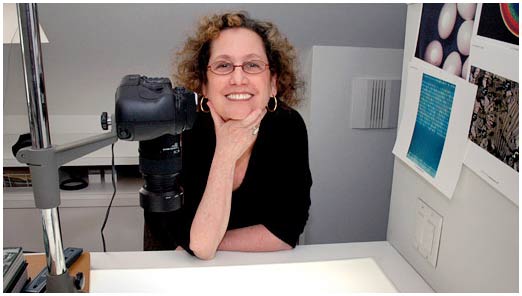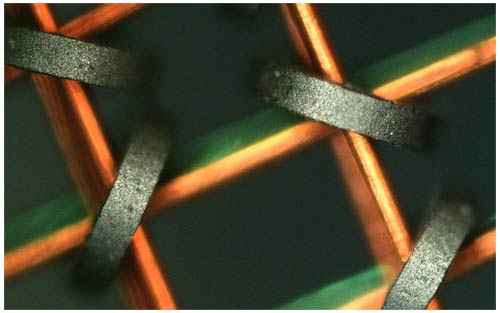Female artist photographing science
With the help of Mrs. Felice Frankel, scientists have turned tedious images of things like yeast in a disc or the surface of a CD into impressive images. According to Dr. George M. Whitesides, a chemist at Harvard University, " she changed the visual face of science ."
Art is not a visible concept
When known as an artist, Felice Frankel often grimaces not like. First of all because the photos she took were not for sale. After receiving a grant from the Guggenheim Museum in 1995, she began to bring her works to the gallery, but no one was sad to see. Secondly, her photos do not include emotions, ideologies or any other message.
She said: "My material is natural phenomena such as: magnetic field, water molecule activity, or growth of bacteria blocks. I don't call it art. Because if it is art, it must say more about the creator of the work, not merely the concepts seen in the images ".

Ms. Felice Frankel in the office at MIT Academy (Photo: Nytimes)
As an artist, a scientific researcher at the Massachusetts Institute of Technology (MIT), and now a senior researcher at the Computer Innovation Institute at Harvard University, she helps researchers. Use cameras, microscopes and some other instruments to display the beauty of science. One of her photographs, the vivid image of a fluid with a lot of iron changing under the impact of the magnet, was so widespread that she felt "fed up with it."
To get that picture, she did a very normal operation. She slid back and forth a yellow note paper beneath the experiment glass where the liquid was placed. That movement does not alter the experimental conditions, but it captures the image of the liquid in a way that attracts so much attention that the National Science Foundation has made a poster. report with that picture.

A model of computer memory chips ( microscope) (Photo: Nytimes)
Scientific images must be appealing because of art
Ms. Frankel is holding conferences throughout the United States on the theme of Pictures and Meaning, and is promoting to establish a program funded by the National Science Foundation on the use of visual images in teaching. science. For colleagues, she is establishing an online website where researchers can discuss the concepts they want to convey in images. But she didn't think her photos had to explain everything."For me, the important thing is to attract people to see scientific pictures, they don't even know it's science," she said.
To achieve this goal, she sometimes corrects images. For example, when she took photos of the bacteria growing on agar, she could see the cracked agar, but she wanted the reader to pay attention only to the bacterial shape, so she used the digital erase. cracks. Another time, she photographed the orange-shaped bacteria, and the photographic device could not reproduce the orange that she could see through a microscope, so she added that color.

Photographs illustrating the structure of a carbon nanotube tube (Photo: Nytimes)
"This art is acceptable, because their purpose is not to conceal or distort scientific information, but to make it clearer," she said. And when such images appear in scientific journals, an untouched original image will be posted online with additional details.
Frankel always tells the reader what she did when creating a photo. She also discussed with colleagues how to do it."If it is acceptable to edit photos to make them look better, provided that the tricks are done," she said.
That's how magazines like Scientific American do when they use her work - they inform readers how the image being talked about has been changed, and how it changes.

Plastic sheets with electronic circuits (Photo: Nytimes)
"Science is always in my soul"
For Frankel, who is 62 years old, this job is a return to a great passion of her youth. Born in Felice Oringel, Brooklyn, she studied at Midwood High School and Brooklyn University, where she majored in biology. After graduating from college, she worked at a cancer research laboratory in Columbia.
But life did not follow the path she wanted. She married Kenneth Frankel. He was taken to Vietnam. When he returned, they moved to Massachusetts, where he worked as a breast surgeon and they had two sons. When Mr. Frankel returned from Vietnam, he brought a gift. It is a very good camera. And she started taking pictures.

Fermentation (yeast) builds up in a laboratory dish (Photo: Nytimes)
Beautiful photos attracted her to continue shooting. She was originally a volunteer photographer for a television station, then for an architect. Soon she began to photograph landscapes for magazines and for a book about modern landscape architecture. She then traveled throughout the United States to photograph landscapes. Then she realized she was on the wrong path. She applied for a Loeb scholarship at Harvard Design School, where she spent two years from 1991, 1992 to finish her university program."I live in a science center, because I really want to go back to science," she said.
One day, someone introduced her to a course in molecular biology, and the professor presented the lesson intuitively. She introduced herself and was invited by the professor to his lab. That professor is Dr. Whitesides."We started talking about the scientific presentation on the blackboard," he recalls, "and at some point she commented that we did very badly, and I told her to show us. better way ".

A computer memory IC taken via electron microscopy, then digitally colored (Photo: Nytimes)
One of the first photos she did in his lab, small droplets of water were placed in rows on an experimental glass plate with a waterproof net, printed on the cover of Science magazine. ."Since then, her influence on scientific communication is huge," Dr. Whitesides said. "In addition," he added, "she has a very good sense of design and color. It is hard to say that she is not an artist." And Frankel said: "Science has always been in my soul."
"My material is natural phenomena such as magnetic fields, water molecules' activity, or growth of bacteria blocks. I don't call them art. Because if it is art, then it must say more about the creator of the work, not merely the concepts seen in the images. "

Iron-rich liquid under the influence of magnets (Photo: Nytimes)

A drop of water (Photo: Nytimes)
Audio Slide Show
Thuc Phuong
- Decode method of photographing human souls
- L 'Oréal - UNESCO: Award for female scientists
- Artist painter
- Google changed the logo to honor the first female engineer in the history of world science
- 5 U70 female scientists receive Kovalevskaia award
- Anonymous female scientists contribute to changing the world
- UNESCO: More and more women do science
- The female model faces hidden in the painting of the French artist
- Three female scientists received a scholarship of VND 300 million
- The 33-year-old Vietnamese female professor of apprentice studies in the US
- Comedy female soldier in ancient tomb 1,000 years
- Photographing the Earth from 1.6 billion km away
 The most famous scientific failures in history
The most famous scientific failures in history Mysterious genius mechanic and the machine froze time
Mysterious genius mechanic and the machine froze time The son carries the 'bad gene' of genius Albert Einstein
The son carries the 'bad gene' of genius Albert Einstein Isaac Newton
Isaac Newton